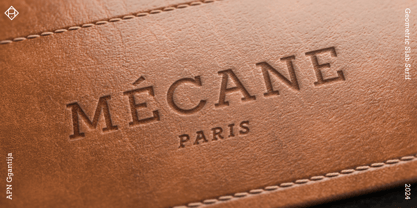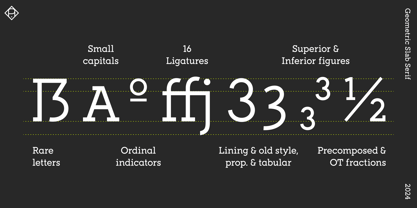APN Ggantija is a postmodern, geometric, monolinear slab serif with semi-humanistic lowercase forms and true italics. It features a generous x-height and open apertures for good legibility in long blocks of text. And it’s also a versatile display typeface that can be used for headlines, subheads and anywhere demanding a strong presence. APN Ggantija offers extensive OpenType support and includes small caps, ligatures, multiple figure and stylistic sets, alternative glyphs, fractions, mathematical symbols and arrows. APN Ggantija supports a wide range of languages, including all European languages written in the Latin script, and comes in 16 styles and 2 variable fonts.
From Industrial Revolution to Modernism and Beyond
Slab serif typefaces first appeared in the early nineteenth century as a product of the Industrial Revolution’s growing demand for bold fonts to advertise the new consumer goods.
Roughly a century later, during the interwar period, a first revival of the “Egyptians”, as these faces were misleadingly called, emerged. They now generally displayed less stroke contrast and embraced a more geometric aesthetic, akin to their contemporary sans serif counterparts.
Embodying modernist ideals of clarity and functionality, these were sleek, architectural designs, austere, intentionally monolithic, and sometimes of brutalist elegance, seemingly owing more to the compass and the ruler than to the pen. This was the starting point of APN Ggantija.
During the late 1960s to late 1970s, a second revival took place, when Adrian Frutiger and Herb Lubalin released their interpretations of slab serif typefaces. From this period, APN Ggantija inherits its rather large x-height.
However, since the geometrically constructed modernist typefaces turned out to be not that functional after all, APN Ggantija also incorporates certain features of humanist faces. These features, along with some alternative glyphs, significantly improve legibility and readability, even in surprisingly small sizes. Consequently, APN Ggantija can be used not only as a display typeface but also excels in body text settings, be it in the analog or digital realm, across various genres and registers.
Furthermore, unlike most of today’s slabs, APN Ggantija is not simply based on a pre-existing sans with slabs slapped on. Instead, it's a purposefully drawn slab, created from the ground up. And, unlike most older typefaces in this category, APN Ggantija includes fully featured true italics.
But Why “Ġgantija”?
I started working on APN Ggantija during a stay on the Maltese island of Gozo, in an apartment nearly within walking distance of the megalithic temple complex of the same name. These UNESCO World Heritage Site temples rank among the earliest free-standing stone buildings and amongst the oldest existing man-made religious structures in the world, with over 5,500 years of age, predating the Egyptian pyramids by a millennium.
The temple's façade and internal walls consist of upright limestone slabs, topped by horizontal stone blocks. When designing a typeface named like this structure, what category more fitting than a—quite blocky—slab serif?
And then of course there’s the name itself, “Ġgantija”, the giantess: To some ears she might sound exotic (pronounced roughly “Juh-gan-tee-ya”), even more exotic probably than the Egyptian sites and cities the early "Egyptian" typefaces were curiously named after…
(PN)
General Properties
• Large x-height for rendering text more evenly, especially in languages with many uppercase letters like German
• Comparatively open apertures to further improve the reading experience, particularly in smaller sizes and body text
• Optically corrected monolinear strokes and geometric core shapes, with mostly static letterforms but a subtle calligraphic (broad nib pen) influence in the lowercase terminals
• Lowercase curves exhibit an angular transition into the stem, with asymmetrical arches, referencing Renaissance antiquas
• Uppercase letters with harmonized modern proportions, rather than following a strict classical (Roman) formal model
• True, semi-serifed Italics with rounded transitions and round counters (letters with stems and bowls), based on a rationalized “script” model
• All glyphs, features, and the widths of tabular numbers are consistent across all styles, including italics, an additional alternative “k” is available in the italics
• Letter spacing favours a steady rhythm over pronounced tightness, thus leading from the 1970s into the 21st century
• The spacing of the lighter weights is optimized for large (display, headline) settings and is therefore rather dense, while the heavier weights are spaced more generously as they will also be used to emphasize parts of (small) body text
• The distribution of weights follows the Impallari progression, resulting in visually consistent intervals between each weight, to ensure that every weight has a corresponding counterpart with a similar level of emphasis
Glyphs, Alternates, OpenType Features
• 780+ glyphs in 16 styles, heavier weights carry a more contemporary flavour
• Multiple alternative glyphs and special or historical glyphs like uppercase sharp S (ẞ) or long s (ſ)
• Mathematical symbols
• Arrows (just type “->” etc., with ligatures activated)
• Supports all European languages—and many more based on the Latin script
• Small caps, for emphasis or acronyms
• 16 ligatures including a special “etc”-ligature
• Case-sensitive forms
• Ordinals
9 Stylistic Sets
• K → Double-junction K (ss01)
• Q → Curvy Q (ss02)
• Q → Swooshed Q (ss03)
• U → Downstroked U (ss04)
• a → Double-storey a (ss05)
• a, g → Crooked a and g (ss06)
• y → Serifed y (ss07)
• y → Round y (ss08)
• k → Looped k (ss09, italics only)
Figures
• Lining figures with a static, consistent shape
• Old style figures with a dynamic, more open shape
• Tabular figures: Both lining and old style figures are available in a tabular format, specifically designed for tables and data presentation, consistent across all styles, including italics
• Superior and inferior figures: A separate set of smaller figures used for exponents and subscripts, respectively
• Fractions: OpenType feature plus an exhaustive selection of predefined fractions for most use cases
• Dotted zeros















